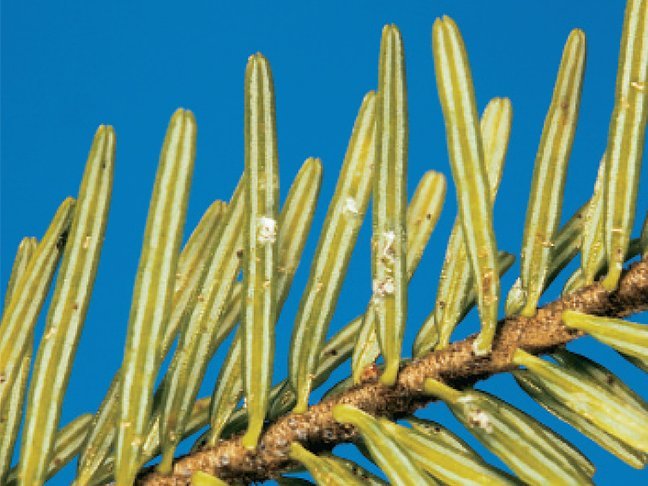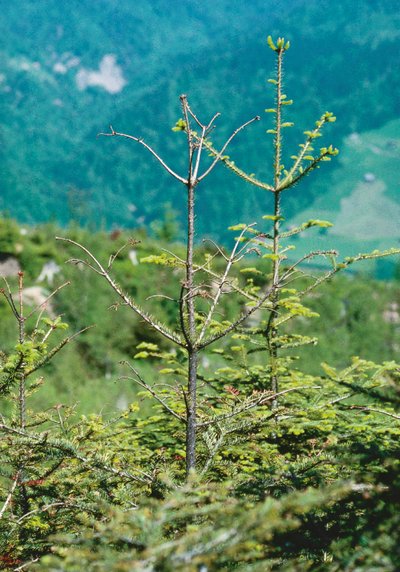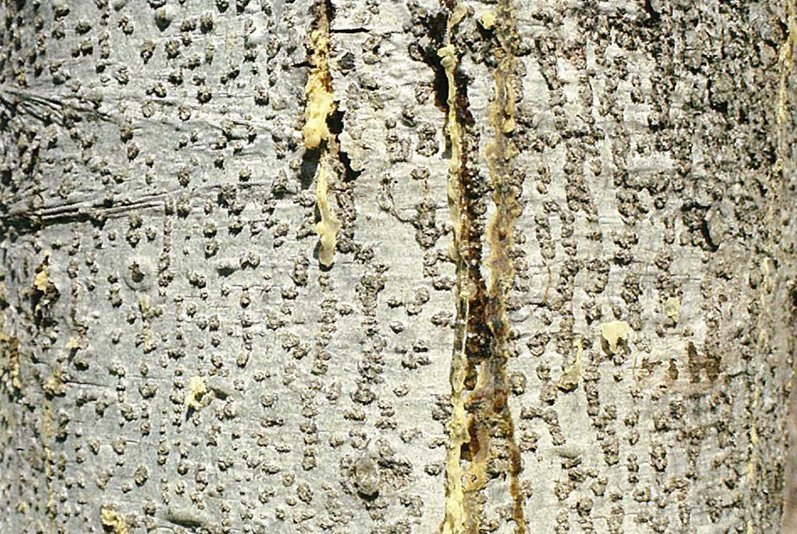The Dreyfusia nordmannianae originates from the higher regions of the west Caucasus, in the eastern Pontus Mountains (Anatolia) and the Crimea. In these mountains the nordmann fir (Abies nordmanniana) builds pure or mixed stands with the oriental spruce (Picea orientalis). The Dreyfusia nordmannianae switches in a complicated life cycle between these conifer species.
In the 1840’s, the Dreyfusia nordmannianae was introduced to central Europe on nordmann firs, successfully populating the silver fir and quickly becoming superior over the long-established European silver fir woolly aphid Dreyfusia piceae due to the fact that effective enemies were missing. The Dreyfusia nordmannianae could not adapt, however to the native Norway spruce (Picea abies).
Around 1880, the Dreyfusia nordmannianae first appeared in Germany as well as in Switzerland, where mainly in the central and eastern plateau typical pictures of an attack could be found. Since their first epidemic occurrence after the turn of the century, they spread very rapidly over the whole of Europe and invaded in the 1920’s and 1930’s all European silver fir areas. The very rapid spreading originated most likely from parks and gardens where nordmann firs were planted as ornamental trees next to oriental spruces. The Dreyfusia nordmannianae was carried into isolated planting areas for the silver fir.

Fig. 1: White wax secretions in June/July on the lower side of the needle and on the May shoots indicate fresh clutches. Photo: Swiss Forest Protection (WSL)
Host trees and attack disposition
The Dreyfusia nordmannianae is very common in the European silver fir forests and the nordmann fir plantations. In parks and gardens other introduced abies species and oriental spruces can be attacked as well. With the silver fir, the Dreyfusia nordmannianae was introduced to North America. The Dreyfusia nordmannianae mainly populate stems with a thin bark, twigs or shoots. Only a few of their stages develop on young May needles. Sun exposed and warm tree parts are preferred.
For the first infestation of the Dreyfusia nordmannianae, vital silver firs with lush green needles are more attractive than yellowish discolored trees with short, flimsy shoots. A first attack usually occurs on free standing young firs up to 1.5 m in height. The population density already significantly increases already during the first vegetation period. From a tree height of 2 m the chance of being attacked drops significantly. On young firs under the umbrella of neighboring trees however, the Dreyfusia nordmannianae develops only with little success and usually die after the following vegetation period. Free standing firs higher than 3.5 m have only a small risk of being attacked.
High population pressure from liberated young stands also increases the risk of latent attacks being established on covered firs in the neighborhood. With the free standing of such firs a gap with a radius of 6 m may already be sufficient for a new dispersion of Dreyfusia nordmannianae. Therefore, important criteria for the dispersion of an attack are horizontal and vertical free standing young firs which are exposed to high radiation and close to the source of an attack.

Fig. 2: On the lower side of younger needles, sucking young larvae can reach a high population density. Photo: Swiss Forest Protection (WSL)
Biology
You can find an extended description of the life cycle in the original article (in German).
Significance and pictures of attack

Fig. 3: After repeated attacks, the firs die from the tip dow. Photo: Swiss Forest Protection (WSL)
As a light and warmth loving insect, Dreyfusia nordmannianae prefers firs which are growing on sun exposed slopes up to 1400 m a.s.l.free standing, at thicket edges or within deer fences. Particularly at risk are young firs up to the age of thirty years, regardless of whether they are planted or naturally grown. More and more older trees are getting attacked so that by now all age classes may be affected.
Under conditions which favor their reproduction, a humid spring followed by warm summers and strong winds, the development and dispersion can progress to an extent that May shoots die off already during the second year after the first attack. On the other hand, the attack may last over years until the fir dies off from the top or until the insect gradation breaks down. The attack can occur significantly in natural fir communities as well as in planted fir stands.
The first striking symptoms of a Dreyfusia nordmannianae attack after the end of the spring shoot are deformations of the May needles which curl down ("bottle brush"), in contrast to the harmless European balsam twig aphid (Mindarus abietinus) where the needles curl up (white wax stripes outside) after an attack. The Dreyfusia nordmannianae tap during their sucking the sieve pipes so that needles and shoots die of "hunger" and "thirst". Usually, the sucking on the bark is not noticeable. Only after repeated and heavy attacks, the young trees die off from the top. The bark of these shoots cracks to pox-like chips followed by a swelling of the shoot base and the buds will no longer burst. After the top dies off, the fir often manages to erect a still living lower branch and to grow a second top which continues the height growth. The overall weakness of the silver fir enables secondary organisms to settle.

Fig. 4: On the developing May shoots, the needles curl down. Photo: Swiss Forest Protection (WSL)
The first striking symptoms of a Dreyfusia nordmannianae attack after the end of the spring shoot are deformations of the May needles which curl down ("bottle brush"), in contrast to the harmless European balsam twig aphid (Mindarus abietinus) where the needles curl up (white wax stripes outside) after an attack. The Dreyfusia nordmannianae tap during their sucking the sieve pipes so that needles and shoots die of "hunger" and "thirst". Usually, the sucking on the bark is not noticeable. Only after repeated and heavy attacks, the young trees die off from the top. The bark of these shoots cracks to pox-like chips followed by a swelling of the shoot base and the buds will no longer burst. After the top dies off, the fir often manages to erect a still living lower branch and to grow a second top which continues the height growth. The overall weakness of the silver fir enables secondary organisms to settle.
Counter measures
For forested areas, no chemicals against the Dreyfusia nordmannianae are currently permitted. Only mechanical measures are possible which is mainly the cutting and burning of severely attacked trees during winter. Sylvicultural measures can prevent severe attacks by the Dreyfusia nordmannianae: firs should preferably be propagated and grown underneath an umbrella, for example underneath a slightly thinned mature stand or mixed with young alder or European rowan.
In Christmas tree plantations outside of the forest, insecticides are permitted and may be applied. But also here, caution is needed. The regulations for the protection of the ground water must be followed and flowering plants growing between the young trees should be removed in advance in order to not endanger bees. The best time for the application is the period shortly before or during the time when the shoots start growing and when new shoots are still clearly bright green. This way the young larvae which migrated onto the young needles can be killed before the needles start curling due to the sucking activities of the Dreyfusia nordmannianae.
Recommended strategy with severe attacks in the forest
Phytosanitary stand management according to the principals of the negative selection. The following points should be considered:
- To remove severely attacked groups of fir trees and to burn them at an appropriate site.
- Severely attacked trees should not be pulled through less severely attacked fir stands (this would further disperse the aphid)
- Firs which may survive with more or less intact top shoots should not be put free in a too radical a way by a first intervention; this would make them even more receptive.
- Not each attacked fir has to be removed! A pole stage forest may be able to recover well.
- Dead (dry) firs do not have to be harvested.
To continue the surveillance, according to the damage development and sylvicultural options, the measure strategy has to be reconsidered and possibly adapted. If there are plenty of other tree species, the fir may has to be given up. The expensive counter measures should not be continued until the last young fir tree has been removed.

